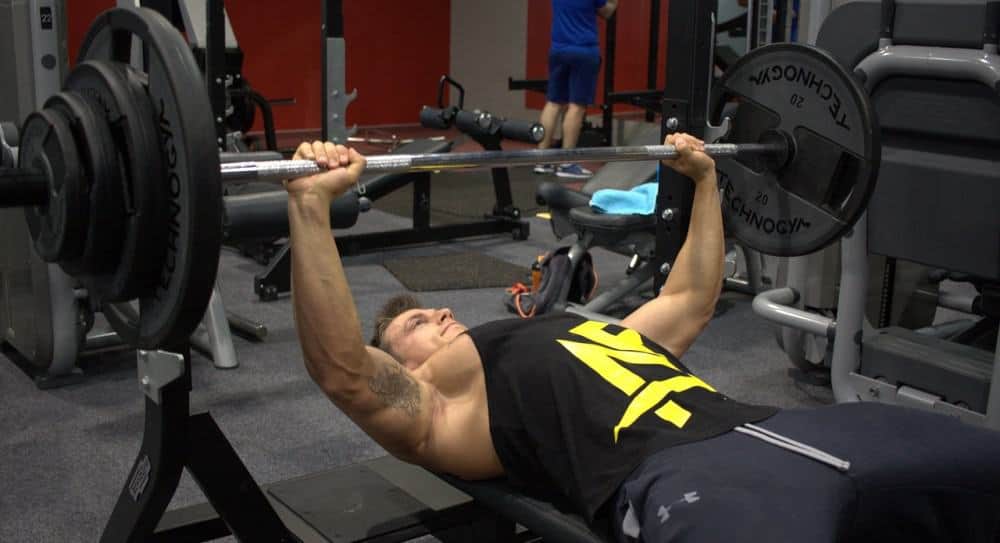Training with a cold, flu, infection – when is sport still reasonable?
I assume most among you know this disappointing feeling. You’re highly motivated, ready to give your right arm to hit the gym but somehow you’re feeling sick.
Frankly, fitness sport can be very ungrateful in such situations.
Do you have that too? Sometimes I already feel as I had never seen a gym from the inside, after just one day without training…
Especially as athletes, we are to be tougher than the main street. Rain, snow, cold or fever, our muscles never rest and the training schedule is on!
We have our goal in mind. Visualized. Being better in the next workout than we’ve been in the previous one.
Seeking to be the best version of ourselves and taking a step closer to our dream every day.
It’s certainly part of training itself to leave one’s own comfort zone, to continue as our body tells us “I don’t want any more”.
Last but not least, sport often gives us energy just when we feel powerless. It’s a give-and-take relationship.
But is all that also true when we fell ill? When is sport still useful and acceptable? Should you already skip the upcoming training for a cold? Or is a workout appropriate as long as we don’t have to lay up to bed?
In this article, you will learn an unusual method by which you can judge for yourself and decide whether training in cold and any other illness makes sense – and when you should rather take a break.
You’ll learn how to if it has really caught you, resume training safely and without relapse.
Is sport useful for a cold?
If you’re a professional athlete, earning one’s bread through sport, then you start in consultation with your team doctor and trainer.
If not, those among yourselves who do not necessarily need to reduce their training, I suggest to slack off and keep it easy.
Fresh air and UV radiation are good, the latter helps to form Vitamin D which supports the immune system.
Walking, easy trotting or cycling are just right if you notice that a cold is catching you.
However, heading over to the gym and literally smashing a workout makes little to no sense. That gets you anywhere but not better in the end.
This weakens your immune system by causing inflammation in the body. As a result, your organism surrenders and you’re flattened on grounds of the numerous construction zones.
To be perfectly frank, a cold only rarely gets better with the sport. On the contrary, it slows down our body’s self-healing powers and lengthens the whole condition.
What should you keep in mind when exercising with a cold?
Not to burn out yourself, that is very important. If you have a cold and a cough, you can jog at a moderate and relaxed pace. However, make sure you do not lose too much fluid or shift any PH values.

The nose is constantly being supplied with blood and thus warmed up, which makes it easier to kill the common cold virus.
Nevertheless, if you are planning a sniffy strength training in the gym, first of all, you should leave your ego outside and not on any terms aim for a new personal record.
Secondly, it is advisable to disinfect your hands after every device if possible. Obviously, at the studio equipment are germs everywhere.
If one is already battered, gear down and take it easy.
Normally, your immune system laughs at these germs, but once you’re caught it’s not funny anymore.
Now you may think, what about exercising at home? Sure, you could do some slipshod dumbbells at home, but anyhow, real training incentives increase the likelihood of getting even sicker.
For all other cold symptoms, keep your feet and dumbbells quit form the start. Incidentally, it is a old wives’ tale that antibiotic is synonymous with sports ban.
There are actually drugs that work well with low-dose training. At the end of the day, it is the safest way to ask your doctor or pharmacist. Most of the time, though, it makes sense to entirely refrain from training for the first few days.
The antibiotic must first build up a level of efficiency in order to fight the bacteria. By virtue of an antibiotic being metabolized by the liver and kidney and broken down, adding more weight just increases the amount of work the liver has to do. Eventually, the effect of the medicine is worse.
To put it simply, the more the metabolism gets going, the worse it can get for the drug level in an antibiotic.
The neck rule
Where do the symptoms occur? That’s an important question.
While doing research for this article, I amusingly found this “neck-rule”, at least for the time being I’ll call it that way.
How does this technique work?
Well, as already stated at the beginning of this paragraph, it’s about where the symptoms occur.
If the symptoms occur below the neck (bronchitis, tonsils, body aches), then you should slack off and refrain from exercising for the present.
For symptoms that appear above the neck (runny nose, sneezing, coughing in the upper neck) it is still viable to hit your training. However, of course with caution and not burn out yourself.
From my personal experience, I can tell you the following. I certainly went a lot of times sick to the gym. It wasn’t always the best decision, but at the end of the day, we need to make those decisions to consequently learn from our past mistakes.
Anyway, although my runny nose was quite annoying, it was almost clear from the outset that I would head to the gym. Eventually, after the workout I felt much better, my head was free and I felt re-energized.
Nevertheless, I don’t want to persuade you to train when being sick, definitely not. But sometimes we humans make mountains out of molehills.
What is my point here?
Honestly, guys, if you don’t feel any good, then take it easy and get some rest. If you just feel a bit stricken but think physical activity may help, then give it a try.
You can use the “neck-rule” as a guideline to orientate yourself toward. It’s not black and white, there is no perfect solution for every situation.
In some cases it can help you to get back on track, in others it triggers the opposite. Be aware of that and decide on how you’re feeling.
To conclude this paragraph, training with a common cold is not a health risk. That’s supported by many sports doctors and professionals.
But what about the risk of delaying the cold? Fortunately, scientists have found that out for us.
Does training with a cold extend the regeneration?
To answer this question, Dr. Tom Weidner at Ball State University conducted a study with a total of 60 runners. He infected them with a common cold, then we divided the subjects into 2 groups.
- Group 1 did a run for about 30-40 minutes every day for one week
- Group 2 took a rest break for one week
The results of the study surprised. Neither training nor rest had a positive or negative effect on the duration of the cold. Both groups needed the same time to properly recover.
Training with a cold is normally “scientifically” allowed and a proved and tested mean by which you can maintain your fitness and maybe even feel better afterward.
However, as said earlier, you should not outspend yourself with such an infection. This only results in a weakened immune system.
Particularly when you start feeling any symptoms or have caught with a cold, nutrition is even more important. Supply your body with sufficient fruits and vegetables for all the essential micronutrients, vitamins and trace elements.
Taking a break – When you should rather stay home
Nevertheless, you should not dismiss every infection lightly as a “common cold”.

Even if I’ve never interrupted my training for years based on a cold and have done well so far: In case of doubt, ask your doctor and other people you trust.
But beyond all measures, listen to your body and stay home if you’re really not feeling well.
It’s not the end of the world to refrain from training for some days.
I know it feels exactly like that, but trust me, if you maintain appropriate nutrition it could be worse. You’ll come back stronger!
For example, if your body temperature is above 37?, training is taboo! Running or strength training with fever will not only worsen the symptoms of your illness but also take a life-threatening risk.
Your heart already has an increased output in case of fever to pump the blood close to the skin surface for cooling.
If you now stress yourself any further, your body temperature will continue to rise and heart rhythm disturbances can occur.
A viral infection is often associated with body aches. If you still head to the gym and train with your muscles being already affected, the only thing that may happen is an injury.
After having talked quite a lot about being sick, are ready to recover? Great!
The right time to resume training
You feel better again, finally. The thermometer shows “green light” and today is the first day you’re feeling stored full of energy. It’s about time.
So what are you waiting for, off to the gym, right?
Relax. Not in a hurry.
Even if the symptoms have already subsided, that does not necessarily mean the disease is completely over. One more day of rest can only be to your benefit.
As a rule of thumb, you might want to consider the 2nd day after you’re feeling better as the starting point.
Of course, slowly and not immediately returning to your previous weights. Start light and take it easy for the first workouts.
Let me give you an example from my personal experience. A few months ago I was quite sick for some weeks, suffering from a cold, sore throat and other symptoms.
Did I acted reasonably and refrained from training? Well, I guess you can guess the answer:D
First and foremost, I dismissed my illness too easily and did not assess it adequately. Thus, I still continued going to the gym over and over.
I got my comeuppance promptly and the whole story started again from scratch. I had to lay up in bed for some more weeks. Trust me, it wasn’t funny at all.
I hope you learn at this point from my mistake and rather training once more a bit lighter than risking another, superfluous wearing on break from training.
After a fever illness, it usually takes about 1-2 weeks until you can train again with your usual accustomed intensity.
Whenever you are in doubt, definitely listen to your body rather than to your training schedule.
Does the risk of disease increase by training?
Moderate training strengthens the immune system. However, too much of a good thing can weaken it again.
The limit depends on many factors, such as your genetics, lifestyle, nutrition, stress levels and just training extent (frequency, intensity etc.)
Let’s take a closer look: At what level of training do you risk additional infections based on a weakened immune system?
Dr. David Niemand from the Appalachian State University conducted research study with 2,300 runners participating in the Los Angeles Marathon at the end of the 1980s.
The study reveals that for most people this limit is around 100 miles per week.
Runners who run well over 100 miles per week had an approximately twice as high risk of infection as those running below 100 miles.
Honestly, 100 miles per week is already a decent job, which will probably exceed less than 10% of all marathon runners.
Although there is no scientific research on particularly strength training at present, I see the risk of overcharging the immune system with light strength training as rather low.
Closing thoughts
You feel sick and are not certain if you should train? The “neck rule” helps you to make the right call quickly.
In addition, pull out the medical thermometer. Training with an elevated body temperature above 37? is an absolute taboo!
In case of doubt, your body should always have the final say, not your training schedule or ego.
What is your experience with exercising when being sick? Do you continue training with a cold? What did not work out for you?
Write a comment below! Also, make sure to follow our social media channels and stay up to date with our latest content!
Thanks for reading,
Claas




